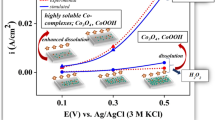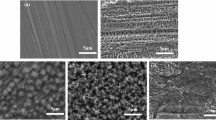Abstract
The dissolution of copper in monoethanolamine (MEA)-complexed cupric ion solution containing different additives was studied. Bridging ligands, such as F−, Cl−, Br−, I−, SCN−, and oxidizers, including S2O8 2−, Cr2O7 2−, MnO4 − were added to this nonammoniacal etching solution to increase the copper dissolution rate. Potentiodynamic methods were employed to elucidate the dissolution mechanism and the corrosion potential (E corr) was found to shift from 10 to 90 mV as opposed to that of the original solution (0.045 M cupric sulfate and 0.225 M MEA) for bridging ligands. In contrast, some conventional oxidizers were also added in the etchant and the E corr did not shift obviously. Therefore, we proposed that copper dissolution proceeds through an ‘inner-sphere’ pathway in solution containing bridging ligands. The electron is transferred from the copper surface into the cupric species through the ligands, which greatly influences the copper dissolution rate. The order of effectiveness of these ligands is SCN− > I− > Br− > Cl− > F−, which is related to their polarizability.
Similar content being viewed by others
References
W. Kantek and J.G. Gordon, J. Electrochem. Soc. 137 (1990) 2672.
S. Dobg, Y. Xie and G. Cheng, Electrochem. Acta 37 (1992) 17.
D. Tromansand T. Ahmed, J. Electrochem. Soc. 145 (1998) 601.
C.A. Melendres, T.J. O'Leary and J. Solis, Electrochim. Acta 36 (1991) 505.
M. Drogowska, L. Brossard and H. Menard, J. Electrochem. Soc. 139 (1992) 2787.
R.H. Sun and D. Tromans, J. Electrochem. Soc. 138 (1991) 3235.
T. Aben and D. Tromans, J. Electrochem. Soc. 142 (1995) 398.
C.R. Shipley Jr, US Patent 3 650 958 (1972).
L.H. Tseng, MS thesis, Tsing-Hua University (June, 1998).
R.J. Flannery, B. Ke, M.W. Grieb and D. Trivich, J. Am. Chem. Soc. 77 (1955) 2996.
W.J. Schwerdtfeger and O.N. McDorman, J. Electrochem. Soc. 99 (1952) 407.
M. Georgiadou and R. Alkire, J. Electrochem. Soc. 140 (1993) 1340.
Q. Luo, R.A. Mackay and S.V. Babu, Chem. Mater. 9 (1997) 2101.
H. Taube, 'Electron Transfer Reactions of Complex Ions in Solution' (Academic Press, New York, 1970).
A.J. Bard, 'Electrochemical Methods: Fundamental and Applications', (John Wiley & Sons, New York, 2nd edn, 2000), p. 116.
M.J. Weaver and F.C. Adson, Inorg. Chem. 15 (1976) 1871.
S.W. Barr and M.J. Weaver, Inorg. Chem. 23 (1984) 1657.
L.W. Wei, M.S. Chao and C.S. Chung, J. Chin. Chem. Soc. 26 (1979) 145.
M. Stern and A.L. Geary, J. Electrochem. Soc. 104 (1957) 56.
X.Q. Wang and Y.F. Zhang, Key Eng. Mater. 20 (1987) 2799.
C.F. Coombs Jr, 'Printed Circuits Handbook' (McGraw-Hill, New York, 1988), chapter 14.
H.W. Richardson, US Patent 5 431 776 (1995).
P.H. Margulies, US Patent 2 987 301 (1961).
D.J. Sykes, US Patent 4 311 551 (1982).
A. Matsumoto, US Patent 3 936 332 (1976).
M.L. Elias, US Patent 4 174 253 (1979).
A.L.B. Marques, J. Zhang, A.B.P. Lever and W.J. Pietro, J. Electroanal. Chem. 392 (1995) 43.
A. Ignaczak, J.A.N.F. Gomesand S. Romanowski, J. Electroanal. Chem., 450 (1998) 175.
V. Climent, A. Rodes, J.M. Orts, A. Aldaz and J.M. Feliu, J. Electroanal. Chem. 461 (1999) 65.
D.P. Schweinsberg, S.E. Bottle and V. Otieno-Alego, J. Appl. Electrochem. 27 (1997) 161.
Y.C. Wu, P. Zhang, H.W. Pickering and D.L. Allara, J. Electrochem. Soc. 140 (1993) 2791.
K. Nakai, H. Nishihara and K. Aramaki, Corrosion 53 (1997) 679.
J.M. Orts, R. Gomez and J.M. Feliu, J. Electroanal. Chem. 467 (1999) 11.
J. Halpern, J. Electrochem. Soc. 100 (1953) 421.
G.K. Gomma, Mater. Chem. Phys. 56 (1998) 27.
C.H. Yang, Y.Y. Wang and C.C. Wan, J. Electrochem. Soc. 143 (1996) 3521.
C.H. Yang, Y.Y. Wang and C.C. Wan, J. Electrochem. Soc. 146 (1999) 4473.
W.B. Jensen, 'The Lewis Acid-Base Concepts; An Overview' (John Wiley & Sons, New York, 1980), p. 260.
R.R. Nazmutdinov, G.A. Tsirlina, O.A. Petrii, Y.I. Kharkats and A.M. Kuznetsov, Electrochim. Acta 45 (2000) 3521.
A.B. Zaki, M.Y. El-Sheikh, J. Evansand S.A. El-Safty, Polyhedron 19 (2000) 1317.
A. Haim, Acc. Chem. Res. 8 (1975) 264.
Author information
Authors and Affiliations
Corresponding author
Rights and permissions
About this article
Cite this article
Shih, CW., Wang, YY. & Wan, CC. Study of the mechanism of additives on copper dissolution in monoethanolamine-complexed cupric ion solution. Journal of Applied Electrochemistry 32, 987–992 (2002). https://doi.org/10.1023/A:1020939319057
Issue Date:
DOI: https://doi.org/10.1023/A:1020939319057




